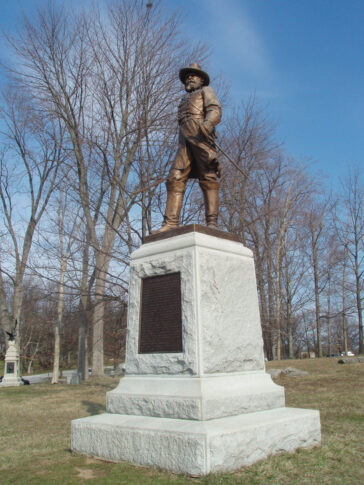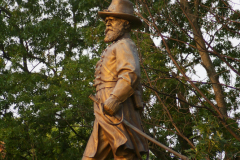Installed before July 1, 1919, probably around 1914.
Location: Located at the northwest corner of Ziegler’s Grove fronting Hancock Avenue.
Description: A standing portrait of General Hays holding a sword in each hand. The sculpture is mounted on rough granite base adorned with an inscription tablet on the front and a bronze tablet of bearing the Pennsylvania State seal. The monument is one of several that the Pennsylvania State Assembly appropriated money for on July 24, 1913. In September 2004, this monument was vandalized when thieves stole the sword.
National Park Service List of Classified Monuments Number: MN207.
Sculptor: Schweizer, J. Otto, 1863-1955, sculptor.
About Brevet Major General Alexander Hays
The son of a Pennsylvania Congressman from the Pittsburgh area, Alexander Hays was born on July 8, 1819. He graduated from West Point in 1844, where he became a close personal friend of U.S. Grant. He served with distinction in the Mexican War and left the army to eventually become a civil engineer in Pittsburgh.
Hays’s Civil War career began with the colonelcy of the 63rd Pennsylvania where he was especially noted by his men for his personal bravery. He was wounded and saw distinguished service during the Seven Days. He was seriously wounded again at Second Bull Run; his brigade was amongst those surrendered during the debacle at Harper’s Ferry.
At Gettysburg, Hays was given command of the Second Corps’ Third Division by seniority. His performance there earned him a brevet promotion in the regular service; however, when the army was reorganized, Hays was demoted back to brigade command. Hays was killed in action near the junction of the Brock and Plank Roads in the Wilderness on May 5, 1864, after being struck in the head by a Minié ball. (The spot on the battlefield where Hays fell is marked by a monument.) He was buried in Pittsburgh’s Allegheny Cemetery. When Grant stopped in that city on his presidential campaign tour, he openly wept over Hays’ grave. A fort and a city in Kansas are named in his honor.










